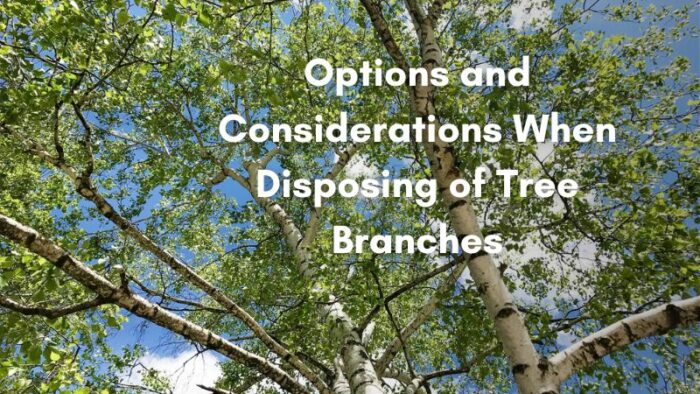It’s usually okay to throw away tree branches. There are several options for disposing of tree branches, depending on the size of the branches and the resources available to you. Some options for disposing of tree branches include:
- Cut the branches into smaller pieces and place them in your green waste bin or yard waste container for pickup by your local waste management company. Many cities and towns offer curbside pickup of yard waste, including tree branches.
- You are renting a wood chipper and turning the branches into mulch. You can use the mulch in your garden or landscaping or give it to friends or neighbors.
- Take the branches to a composting facility or compost them yourself. Tree branches can be added to a compost pile along with other organic materials, such as grass clippings and food scraps.
- They are hiring a tree removal service to haul away the branches. This can be a good option if the branches are large or you don’t have the tools or resources to dispose of them yourself.
It is important to note that some cities and towns have specific regulations or restrictions on the disposal of tree branches, so it may be necessary to check with your local government or waste management company before disposing of tree branches.
Is It Okay to Put Branches in a Regular Trash Bin?
It depends on the size of the tree branches and the regulations in your area. Some cities and towns allow small branches and twigs to be placed in regular trash bins, while others have specific rules or restrictions on the disposal of tree branches. Cutting larger branches into smaller pieces before disposing of them is generally recommended, as this can make it easier for waste management companies to handle and process the branches.
In some cases, it may be necessary to place tree branches in a separate yard waste container or green waste bin for pickup by the waste management company. Many cities and towns offer curbside pickup of yard waste, including tree branches, as an alternative to placing them in the regular trash bin.
It is always a good idea to check with your local government or waste management company to determine the proper disposal methods for tree branches in your area. They can provide information on any specific regulations or restrictions that may apply and any available options for disposing of tree branches.

Possible Safety Concerns
There are a few safety concerns to consider when disposing of tree branches:
- Wear protective gear: When handling tree branches, it is essential to wear protective equipment, such as gloves and safety glasses, to protect yourself from cuts, scrapes, and debris.
- Use proper lifting techniques: If you are lifting and carrying tree branches, be sure to use proper lifting techniques to avoid strains and injuries. Keep your back straight, lift with your legs, and avoid twisting your body.
- Use appropriate tools: Use proper tools, such as loppers or pruning shears, to cut branches into smaller pieces. Avoid using tools not designed for cutting branches, as they may be dangerous or ineffective.
- Dispose of branches properly: Follow the proper disposal methods for tree branches in your area to ensure that they are disposed of safely and efficiently. For example, if you use a wood chipper, follow the manufacturer’s instructions for operation and safety.
Following these safety tips can help reduce the risk of accidents and injuries when disposing of tree branches.
Composting Benefits
Composting tree branches can provide several benefits:
- Nutrient recycling: When tree branches are broken down through the composting process, they release valuable nutrients into the soil, benefiting plants and soil health.
- Soil improvement: Compost made from tree branches can improve soil structure and fertility by increasing the soil’s ability to retain moisture and nutrients. It can also help to reduce soil erosion and compaction.
- Waste reduction: Composting tree branches help to reduce waste by turning organic materials that would otherwise be sent to a landfill into a valuable resource.
- Carbon sequestration: Composting organic materials, such as tree branches, can help to sequester carbon from the atmosphere, as the organic matter in the compost decomposes and releases carbon dioxide.
- Water conservation: Compost can help retain moisture in the soil, reducing the need for irrigation and conserving water resources.
Overall, composting tree branches can be a sustainable and environmentally friendly way to dispose of yard waste and improve soil health.
Recycling Options
There are several recycling options for tree branches, including:
- Wood chipping: One option is to rent or purchase a wood chipper and turn the branches into mulch. The mulch can be used in your garden or landscaping or given away to friends or neighbors.
- Firewood: Another option is to cut the branches into smaller pieces and use them as firewood. This can be a good option if you have a fireplace or wood-burning stove or want to use the branches for outdoor cooking or heating.
- Donating branches to a community group or organization: Some community groups or organizations may be interested in using tree branches for projects such as building shelters or composting.
- Selling branches to a woodlot or lumber mill: If you have a large number of branches, you may be able to sell them to a woodlot or lumber mill for use as wood chips or firewood.
- Composting: As mentioned earlier, tree branches can be added to a compost pile along with other organic materials, such as grass clippings and food scraps. The compost can then enrich the soil and improve plant growth.
It is important to note that some cities and towns have specific regulations or restrictions on the disposal of tree branches, so it may be necessary to check with your local government or waste management company before recycling tree branches.
Repurposing Tree Branches
There are several ways to repurpose tree branches instead of throwing them away:
- Use them as garden stakes or plant supports: Tree branches can be used as stakes to support plants or as trellises for climbing plants.
- Make furniture or home decor: Tree branches can create rustic furniture or home decor items, such as tables, chairs, shelves, or wall hangings.
- Create a natural fence or privacy screen: Tree branches can create a natural fence or privacy screen around your yard or garden.
- Use them as firewood: If you have a fireplace or wood-burning stove, you can use tree branches.
- Turn them into bird feeders or birdhouses: Tree branches can create homemade bird feeders or birdhouses, providing a natural habitat for birds.
- Use them as natural mulch: Tree branches can be used as a natural mulch around plants, helping to retain moisture and suppress weeds.
By repurposing tree branches, you can give them a new life and reduce waste. These are just a few ideas, but many other ways to repurpose tree branches depend on your creativity and resources.
Conclusion
Tree branches can be disposed of or recycled in several ways, depending on the size of the branches and the resources available to you. Some options include placing them in a green waste bin or yard waste container for pickup, turning them into mulch with a wood chipper, composting them, hiring a tree removal service to haul them away, or repurposing them for use in your garden or home.
It is essential to follow the proper disposal methods for tree branches in your area to ensure that they are disposed of safely and efficiently.

